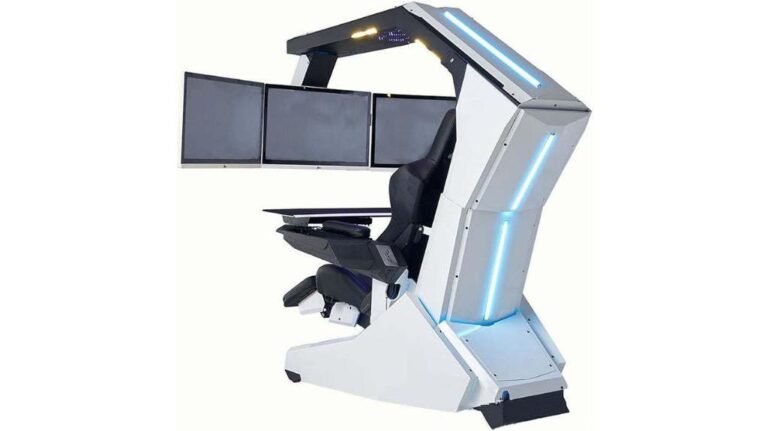Energy-Saving Tech for Your Home Office
Looking to make your home office more energy-efficient? Look no further!
Discover the latest energy-saving tech that can help you reduce your carbon footprint and save on utility bills. From smart power strips to solar-powered chargers, there are plenty of options to choose from.
With programmable thermostats and energy-efficient lighting, you can create a comfortable and eco-friendly workspace.
So, why wait? Take control of your energy usage and transform your home office into a sustainable haven.
Key Takeaways
- Smart power strips and LED lighting are effective ways to optimize energy usage and reduce standby power consumption in your home office.
- Programmable thermostats and eco-friendly printers can help minimize energy consumption and waste, contributing to a greener workspace.
- Investing in solar-powered chargers and energy monitoring systems can provide sustainable and renewable energy solutions while optimizing energy efficiency.
- Customizing computer settings, properly insulating and weatherstripping your workspace, and choosing green office furniture and equipment are additional ways to save energy and reduce environmental impact in your home office.
Smart Power Strips: Efficiently Manage Your Devices
You can easily cut down on wasted energy by using eco-friendly power strips to efficiently control and manage all your devices. These smart power strips are designed to optimize energy usage and reduce standby power consumption, making them an essential addition to your home office setup.
Energy-efficient power management is crucial in today’s world, where electricity usage continues to rise. By using smart power strips, you can minimize energy wastage and lower your electricity bills. These power strips are equipped with advanced features that allow you to control individual outlets, ensuring that only the necessary devices are powered on at any given time.
One of the key features of eco-friendly power strips is their ability to detect when a device is in standby mode and automatically cut off power to that outlet. This eliminates the standby power consumption of devices such as printers, monitors, and speakers, which can account for a significant portion of your energy usage.
Additionally, smart power strips often come with built-in timers and surge protection capabilities. The timers allow you to schedule when certain devices should be powered on or off, enabling you to further optimize your energy usage. The surge protection feature safeguards your devices from power surges and voltage fluctuations, ensuring their longevity and reliability.
Energy-Efficient Lighting: Brighten Your Workspace Responsibly
To create a more energy-efficient workspace, consider using LED lights and natural lighting sources. LED lights are a great choice for your home office because they’re highly energy-efficient and have a longer lifespan compared to traditional incandescent bulbs. LED lights use up to 80% less energy and can last up to 25 times longer, making them a smart choice for energy conservation. Additionally, LED lights produce very little heat, reducing the need for extra cooling in your workspace.
When it comes to natural lighting, take advantage of the sunlight by positioning your desk near a window or using skylights if available. Natural lighting not only helps reduce energy consumption, but it also provides a more pleasant and productive working environment. However, make sure to position your workspace in a way that avoids glare on your computer screen.
In a smart home setup, you can take your energy-efficient lighting to the next level. Connect your LED lights to a smart lighting system that allows you to control and schedule the lighting in your home office. This way, you can easily turn off lights when they aren’t needed or dim them to save energy. Smart lighting systems can be controlled through your smartphone or integrated with voice assistants like Amazon Alexa or Google Assistant.
Programmable Thermostats: Optimize Your Home Office Temperature
To maintain an optimal temperature in your home office, consider using programmable thermostats. These devices give you the ability to control and schedule the temperature settings in your workspace, helping you optimize energy usage and create a comfortable environment. With programmable thermostats, you can set different temperature levels for different times of the day, allowing you to save energy when the office is not in use.
Here is a table outlining the benefits of using programmable thermostats for temperature control in your home office:
| Benefits of Programmable Thermostats |
|---|
| Energy optimization |
| Temperature control |
| Cost savings |
Programmable thermostats optimize energy usage by allowing you to set specific temperature levels for different times of the day. For example, you can program the thermostat to lower the temperature during the night when the office is not in use, and raise it before you start working in the morning. This helps reduce energy consumption and lower your utility bills.
Temperature control is another key advantage of programmable thermostats. You can easily adjust the temperature to your preference, ensuring a comfortable and productive workspace. Whether you prefer a slightly cooler environment for increased focus or a warmer setting for added comfort, programmable thermostats give you the flexibility to customize the temperature according to your needs.
Eco-Friendly Printers: Reduce Waste and Save Resources
Looking for ways to reduce waste and save resources in your home office? Consider investing in eco-friendly printers.
These sustainable printing solutions not only minimize environmental impact but also offer cost-effective options for your printing needs.
With eco-friendly printers, you can save on energy consumption, reduce paper waste, and contribute to a greener workspace.
Sustainable Printing Solutions
Invest in an eco-friendly printer to minimize waste and conserve resources in your home office. By adopting sustainable printing solutions, you can make a significant impact on the environment. Here are three ways an eco-friendly printer can help you achieve this:
-
Minimizing paper waste: Eco-friendly printers come with features like automatic double-sided printing and N-up printing, which allow you to reduce the amount of paper used for printing. This not only saves trees but also reduces the need for disposal and recycling.
-
Sustainable ink cartridges: Eco-friendly printers use ink cartridges that are made from recycled materials and are easily recyclable themselves. They also offer options for refilling ink cartridges, reducing the production of new cartridges and the associated waste.
-
Energy-efficient operation: Eco-friendly printers are designed to consume less energy during printing, standby, and sleep modes. This not only saves electricity but also lowers your utility bills.
Investing in an eco-friendly printer is a practical and responsible choice for your home office, as it helps you minimize waste, conserve resources, and contribute to a sustainable future.
Minimizing Environmental Impact
Choose an eco-friendly printer to minimize your environmental impact and save valuable resources in your home office.
When it comes to minimizing waste and reducing your carbon footprint, opting for sustainable materials in your printing equipment is crucial. Eco-friendly printers are designed to use less energy and produce fewer emissions compared to traditional printers. These printers are built using sustainable materials such as recycled plastics and biodegradable components, ensuring that they’ve a minimal impact on the environment throughout their lifecycle.
Additionally, eco-friendly printers often come with features like automatic double-sided printing and ink-saving modes, helping you conserve paper and ink.
Cost-Effective Eco-Friendly Options
Save money and reduce your environmental impact by opting for an eco-friendly printer in your home office. When it comes to cost-effective technology for a sustainable home office, eco-friendly printers are a great option. Here are three reasons why:
-
Reduced Waste: Eco-friendly printers are designed to minimize paper waste by offering features like duplex printing and automatic double-sided scanning. This not only saves resources but also reduces the need for paper replenishment.
-
Energy Efficiency: These printers are built with energy-saving technologies, such as sleep mode and power-saving settings. They consume less power during operation, resulting in lower electricity bills and a smaller carbon footprint.
-
Recyclable Materials: Many eco-friendly printers are made from recyclable materials, reducing the need for raw resources. They also come with easy-to-recycle ink cartridges, ensuring that the entire printing process is environmentally friendly.
Solar-Powered Chargers: Harness the Sun’s Energy for Your Devices
You can rely on solar-powered chargers to effortlessly charge your devices while also reducing your dependence on traditional energy sources. With the advancement of technology, solar-powered chargers have become more efficient and affordable, making them an excellent choice for environmentally conscious individuals.
One option to consider is solar-powered backpacks, which have integrated solar panels that can capture sunlight and convert it into usable energy on the go. These backpacks are designed with multiple compartments to store your devices and keep them organized while charging. They’re perfect for outdoor enthusiasts, travelers, or anyone who needs to charge their devices while on the move.
Another option is portable solar panels, which are compact and easy to carry. These panels can be set up anywhere with access to sunlight, providing a convenient way to charge your devices even when you’re away from home. Portable solar panels come in various sizes and power outputs, allowing you to choose the one that best suits your needs. They’re also equipped with built-in USB ports, making it easy to connect your devices for charging.
By harnessing the power of the sun, solar-powered chargers offer a sustainable and renewable energy solution for charging your devices. They not only reduce your carbon footprint but also provide a reliable source of power, especially in areas with limited access to electricity.
Energy Monitoring Systems: Track and Analyze Your Power Usage
Ready to take control of your power usage?
Energy monitoring systems allow you to efficiently consume energy by tracking and analyzing your power usage in real-time.
With the ability to monitor your electricity consumption, you can identify energy-saving opportunities and make adjustments to reduce your electricity bills.
Efficient Energy Consumption
Take advantage of an energy monitoring system to easily track and analyze your power usage in your home office. This efficient technology allows you to gain insights into your energy consumption and find ways to save electricity.
Here are three reasons why an energy monitoring system is a must-have for your home office:
-
Real-time data: With an energy monitoring system, you can instantly see how much power each device in your office is consuming. This allows you to identify energy-hungry appliances and make adjustments accordingly.
-
Set goals and track progress: You can set energy-saving goals and monitor your progress over time. This helps you stay motivated and make informed decisions to reduce your energy consumption.
-
Cost savings: By understanding your power usage patterns, you can make changes to optimize energy efficiency and reduce your electricity bills. An energy monitoring system empowers you to make smarter choices and save money in the long run.
Investing in an energy monitoring system is a practical and effective way to achieve efficient energy consumption in your home office.
Real-Time Power Monitoring
An energy monitoring system provides you with real-time power monitoring capabilities to track and analyze your power usage in your home office. With real-time energy monitoring, you can gain valuable insights into your energy consumption patterns and make informed decisions to optimize your energy usage.
These systems use smart energy management technology to collect and analyze data from your devices and appliances, giving you a detailed breakdown of your power usage. By monitoring your energy usage in real-time, you can identify energy-hungry devices and adjust your usage accordingly.
This can help you reduce your energy consumption, lower your electricity bills, and contribute to a more sustainable environment. With the convenience of real-time power monitoring, you can take control of your energy usage and make smarter choices for your home office.
Reduce Electricity Bills
Start tracking and analyzing your power usage with energy monitoring systems to reduce your electricity bills. By using these systems, you can minimize energy usage and save money in the long run.
Here are three benefits of energy monitoring systems:
-
Real-time data: Energy monitoring systems provide real-time data on your power usage, allowing you to see which appliances or devices are consuming the most electricity. This knowledge empowers you to make informed decisions on how to reduce your energy consumption.
-
Identify energy vampires: Energy monitoring systems can help you identify energy vampires, which are appliances or devices that continue to consume power even when they’re turned off or in standby mode. By unplugging or switching off these energy vampires, you can significantly reduce your electricity bills.
-
Integration with smart home automation: Energy monitoring systems can be integrated with smart home automation systems, allowing you to control and monitor your power usage remotely. This integration enables you to easily automate energy-saving measures, such as turning off lights or adjusting thermostat settings when you’re not at home.
Incorporating energy monitoring systems into your home office setup is a practical and effective way to reduce your electricity bills. With the ability to track and analyze your power usage, you can take control of your energy consumption and save money.
Energy-Saving Computer Settings: Customize Your Device’s Efficiency
Adjust your computer’s power settings to maximize energy efficiency. By customizing your device’s power settings, you can reduce energy consumption and save on electricity bills. Most operating systems offer power management options that allow you to customize your computer’s behavior when it’s idle or in use.
One effective way to optimize energy efficiency is by creating custom power saving modes. These modes can be tailored to your specific needs, allowing you to strike a balance between power savings and performance. For example, you can configure your computer to automatically enter a low-power mode after a certain period of inactivity. This will reduce energy consumption and extend the battery life of laptops.
Another important aspect to consider is using energy-efficient screens. Modern computer monitors come with various power-saving features that can significantly reduce energy usage. Look for monitors with Energy Star certification, as they meet strict energy efficiency guidelines set by the Environmental Protection Agency. Additionally, adjusting the screen brightness and using darker backgrounds can help save energy.
Insulation and Weatherstripping: Maintain a Comfortable and Efficient Workspace
To maintain a comfortable and efficient workspace, make sure your insulation is properly installed and weatherstripping is in place.
Insulation plays a crucial role in regulating the temperature and reducing energy waste in your home office. Here are some tips for insulation maintenance:
-
Check for gaps and cracks: Inspect your walls, windows, and doors for any gaps or cracks that could allow air leaks. Use caulk or weatherstripping to seal these openings and prevent heat loss or gain.
-
Inspect attic insulation: Proper insulation in your attic can significantly improve energy efficiency. Make sure it’s evenly distributed and free from damage. If needed, add more insulation to achieve the recommended R-value for your area.
-
Consider insulation for floors and ceilings: If your home office is located in a basement or above a garage, insulating the floors and ceilings can help maintain a comfortable temperature. Insulated floors can also reduce noise transmission.
In addition to insulation, weatherstripping is another important element in maintaining a comfortable workspace. Here are some weatherstripping tips:
-
Check for gaps around windows and doors: Inspect the seals around your windows and doors for any signs of wear or damage. Replace or repair weatherstripping as needed to prevent drafts.
-
Use door sweeps: Install door sweeps at the bottom of exterior doors to seal gaps and prevent air infiltration. This simple addition can greatly improve energy efficiency.
-
Install window film: Window film can provide an additional layer of insulation by reducing heat transfer through your windows. Choose a film that suits your needs, such as UV-blocking or insulating film.
Green Office Furniture: Sustainable and Stylish Solutions
When setting up your home office, consider incorporating green office furniture for sustainable and stylish solutions. Sustainable office decor and eco-friendly office supplies not only contribute to a healthier environment but also create a more pleasant and productive workspace. By choosing furniture made from sustainable materials and manufacturing processes, you can reduce your carbon footprint and support the preservation of natural resources.
One option for green office furniture is to select pieces made from recycled or reclaimed materials. These materials can include reclaimed wood, recycled plastic, or repurposed metal. By giving new life to old materials, you are reducing waste and minimizing the need for new resources. Additionally, look for furniture that is certified by recognized eco-labels such as Forest Stewardship Council (FSC) or Cradle to Cradle (C2C), which ensure sustainable sourcing and manufacturing practices.
Another consideration is the use of non-toxic and low-emission materials in your office furniture. Harmful chemicals found in some furniture can contribute to indoor air pollution and negatively impact your health. Look for furniture made with water-based adhesives, low-VOC (Volatile Organic Compounds) finishes, and formaldehyde-free materials.
To help you make informed choices when selecting green office furniture, consider the following table:
| Furniture Type | Sustainable Material | Eco-Friendly Features |
|---|---|---|
| Desk | Reclaimed wood | Water-based finish |
| Chair | Recycled plastic | Low-VOC upholstery |
| Bookshelf | Bamboo | Formaldehyde-free |
| File cabinet | Recycled metal | Powder-coated finish |
| Lighting | Sustainable metals | Energy-efficient bulbs |
Remote Work Solutions: Minimize Commuting and Energy Consumption
When it comes to remote work solutions, there are several strategies you can employ to minimize commuting and reduce energy consumption.
One effective way is to opt for virtual meetings instead of traveling for in-person meetings, which not only saves time but also reduces carbon emissions.
Additionally, choosing energy-efficient lighting options and investing in power-saving office equipment can help lower your energy consumption and contribute to a greener home office environment.
Virtual Meetings Vs. Travel
By using virtual meetings instead of traveling, you can significantly minimize commuting and energy consumption. Virtual collaboration offers a range of benefits that can help reduce the environmental impact of business travel. Here’s why you should consider virtual meetings as a remote work solution:
-
Reduced carbon footprint: Virtual meetings eliminate the need for air travel or long-distance commuting, resulting in a significant reduction in greenhouse gas emissions.
-
Energy savings: Traveling for meetings involves energy-intensive modes of transportation, such as cars or airplanes. By opting for virtual meetings, you can conserve energy and reduce your overall energy consumption.
-
Time and cost savings: Virtual meetings save both time and money by eliminating the need for travel expenses, such as transportation, accommodation, and meals.
Embracing virtual meetings not only supports remote work but also contributes to a more sustainable and energy-efficient future.
Energy-Efficient Lighting Options
You can save energy and reduce your electricity costs by using energy-efficient lighting options in your home office. By choosing the right bulbs and integrating natural light, you can create a well-lit workspace while minimizing energy consumption.
Here are some energy-efficient lighting options you can consider:
| Lighting Option | Energy Efficiency | Lifespan |
|---|---|---|
| LED Bulbs | Very high | Long |
| CFL Bulbs | High | Medium |
| Halogen Bulbs | Moderate | Short |
| Incandescent | Low | Short |
LED bulbs are the most energy-efficient option, consuming up to 80% less energy than traditional incandescent bulbs. They also have a longer lifespan, reducing the need for frequent replacements. CFL bulbs are also a good choice, offering high energy efficiency and a medium lifespan. Halogen bulbs are less efficient, while incandescent bulbs are the least energy-efficient option.
To further reduce energy consumption, make the most of natural light in your home office. Position your desk near windows and use light-colored curtains or blinds to maximize the amount of natural light entering the room. This not only saves energy but also creates a more pleasant and productive working environment.
Power-Saving Office Equipment
To minimize commuting and energy consumption, consider using power-saving office equipment to create a more efficient and sustainable home office. By utilizing smart power management and energy-efficient appliances, you can significantly reduce your energy usage and environmental impact.
Here are three ways power-saving office equipment can benefit your home office:
-
Smart power strips: These devices automatically cut power to peripheral devices, such as printers and monitors, when not in use. This eliminates standby power consumption and reduces energy waste.
-
Energy-efficient desktop computers: Opt for computers with Energy Star certification, as they’re designed to consume less electricity without sacrificing performance. Look for models with low power consumption in both active and idle states.
-
LED monitors: LED monitors aren’t only more energy-efficient than traditional LCD monitors, but they also offer better image quality and lifespan. They consume less power and emit less heat, helping to keep your office cool and comfortable.
Investing in power-saving office equipment is a smart choice to optimize energy consumption and create a more sustainable home office environment.
Conclusion
In conclusion, by implementing energy-saving technologies in your home office, you can create a sustainable and efficient workspace.
From smart power strips to solar-powered chargers, these innovative solutions not only reduce your energy consumption but also save resources and promote eco-friendly practices.
With the right tools and mindset, you can transform your home office into a symbol of environmental responsibility, where productivity and sustainability coexist harmoniously.





